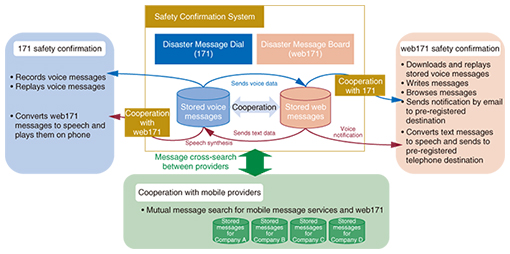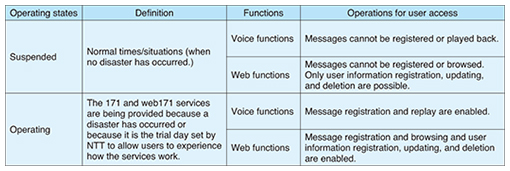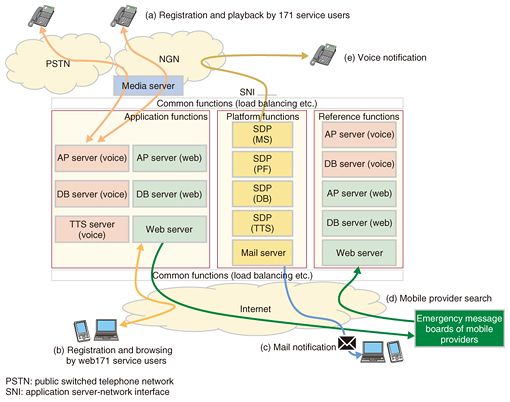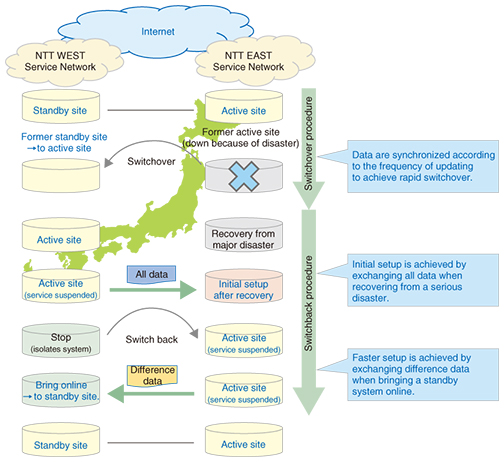 |
|||||||||
|
|
|||||||||
|
Regular Articles Vol. 13, No. 12, pp. 70–76, Dec. 2015. https://doi.org/10.53829/ntr201512ra2 Improving Inter-system Cooperation and User Convenience in Confirming Personal Safety during DisastersAbstractThe need for effective ways to check on the safety of persons in times of disaster has been increasing in recent years. Personal safety information in times of disaster has been handled separately for different types of user terminals, different media (voice, text, etc.), and different networks. NTT Network Service Systems Laboratories has been developing a system that integrates those separate services to work cooperatively and to provide a unified service for simple and certain communication and confirmation of personal safety. Here, we describe the Personal Safety Confirmation System and the functions it provides. Keywords: safety confirmation, service providers, disaster response 1. IntroductionThe major earthquake disaster that occurred in eastern Japan on March 11, 2011 greatly damaged the telecommunication infrastructure, and a number of lessons on maintaining communication during a disaster were subsequently learned. As a result, a Japanese Ministry of Internal Affairs and Communications (MIC) study group was formed to study ways of ensuring communication during major disasters and other emergencies. This study group investigated how best to deal with network congestion during an emergency, how to maintain communication when a base station or relay station is damaged, what should be done with future network infrastructure considering experience from past disasters, how the Internet can be used in the future, and other such issues related to ensuring communication in emergency situations [1]. In terms of confirming personal safety, those studies found that during the aftermath of the 2011 disaster, only a limited number of people in the disaster area were easily able to use the Internet, particularly social media, and they were thus unable to communicate what was needed in the disaster area in a timely and accurate fashion. That resulted in a mismatch of what was provided and what was needed. Consequently, it is now necessary to work towards eliminating information disparities and raise information and communication technology (ICT) literacy, and to develop terminals and services that have high usability for the elderly and others. 2. Efforts by the NTT GroupIn response to the social needs described above, we have been working on a Personal Safety Confirmation System for all NTT Group companies. The objective with this system is to be able to easily confirm the personal safety of others during a disaster, regardless of network, terminal, or type of media. We are moving forward with this work guided by the following principles and objectives: 1) Achieving the capability to respond to increases in mobile network traffic or other such changes in network conditions 2) Achieving cooperation between multiple personal safety information systems (fixed-line and mobile networks, voice and web services) 3) Providing services that do not require a high level of user ICT literacy 4) Achieving higher usability and convenience in registering and checking information Here, we explain the functions for message registration, replay, browsing, and search, which are the basic functions of the Personal Safety Confirmation System, and we describe the implementation of functions for inter-system cooperation. 3. Service overviewThe Personal Safety Confirmation System is based on the Disaster Message Dial (171) and Disaster Message Board (web171) services provided by NTT EAST and NTT WEST. An overview of the system is presented in Fig. 1.
Disaster Message Dial (171) is a dial-up service that enables users in areas affected by a disaster to register messages over a telephone line when it is difficult to place a telephone call. The registered messages can be accessed via the Internet or over the phone. The Disaster Message Board (web171) service makes it possible to register and browse registered messages via the Internet. Interworking between the 171 and web171 services enables mutual confirmation of messages. A service for sending email and telephone notifications to pre-registered destinations is also provided. Additionally, cooperation with various mobile providers enables mutual message search functions with the systems they provide. 4. System overviewThe operating states and definitions of this system are explained in Table 1. Voice functions are provided by the 171 service, and web functions are provided by the web171 service. Message registration, replay, and browsing services are suspended during normal times when no disaster has occurred, although user information can be registered, updated, and deleted using the web functions. When the system changes to the operating state because a disaster has occurred, message registration, replay, and browsing are enabled.
An overview of the system and its functions are presented in Fig. 2. The system comprises application functions, platform functions, reference functions, and common functions.
(1) Application functions Two functions are possible: voice functions and web functions. The voice functions implement registration and replay by 171 users ((a) in Fig. 2). When there is a user request for message registration in the Next Generation Network (NGN), the media servers perform call termination and conversion of voice message content to voice files, the application servers (voice) send and receive the voice files, and the database servers (voice) perform database management. When there is a user request for a message replay, the voice message that corresponds to the specified phone number is played back. The web functions implement registration and browsing by web171 users ((b) in Fig. 2). When the web server receives a request, the application servers (web) process the text data and the database servers (web) manage the database. When there is a user request to browse messages, the text message that corresponds to the specified phone number is displayed. (2) Platform functions The service delivery platform (SDP)*1 includes five servers that have different roles. Upon a user request for message registration or replay, the SDP (PF (platform)) server receives requests from the application server (web) for media conversion, call origination, or another function, and provides additional services. The SDP (DB (database)) server performs database management, the SDP (TTS (text to speech)) converts text to voice files, the SDP (MS (media server)) plays the voice file on the user terminal, and the mail server sends and receives email ((c) and (e) in Fig. 2). (3) Reference functions These functions store data on the content of the various application function servers and handle message search requests from mobile providers ((d) in Fig. 2). (4) Common functions These functions comprise load balancers, which distribute the load of communication over equipment that has a redundant configuration and other such network devices. 4.1 Message information media (speech and text) distribution and notification functionsCross-checking of message data between the 171 and web171 services is possible. For example, the content registered as a voice message in the 171 service can be downloaded from web171 to a terminal as a voice file ((a) to (b) in Fig. 2). Also, the content of web171 text messages can be converted to speech for playback by the 171 service ((b) to (a) in Fig. 2). A function for sending notifications by email or phone, even if the user does not access the system to check for messages, has also been implemented ((c) and (e) in Fig. 2). 4.2 Cooperation with mobile providers for text message browsingThe web functions also work in cooperation with mobile providers. The improvement described here makes it possible for a web171 user to check for messages registered in the system of a mobile provider ((d) in Fig. 2). If there are messages that correspond to the search keywords, links to the message board of the mobile provider are displayed. When a search request from a mobile provider is received, a message search is performed using the phone number as the search key. This system implements the functions described above to realize interworking across media and cooperation with mobile provider systems to provide users with a unified way to check messages, which previously had to be done independently for each system.
5. Advantages of the system5.1 System reliability(1) Handling a heavy concentration of search requests from mobile providers One problem with achieving cooperation among providers is handling large numbers of search requests (Fig. 3). In implementing this function, there was concern that search requests from mobile providers, which have many more users than fixed-line phones, may overwhelm the processing of message registration and access by users of the 171 and web171 services. We therefore divided the functions into a) application functions for registration and searching of safety confirmation information and b) reference functions for information referencing and access between providers. Disruption can thus be controlled, even when numerous search requests from multiple mobile providers are received. This separation of functions also enables flexibility in handling the addition of mobile providers and changes in service number ranges.
(2) Site switchover The process of switching from an active site to a standby site and switching back when a major disaster has occurred is shown in Fig. 4. When the service is operating, the system settings, user information, and other data are stored in one of two types of databases according to the frequency of updating. Data that are updated with high frequency are synchronized between sites as needed; data that are updated with low frequency are synchronized periodically. As a result, site switchover can be done quickly. Also, a technique for incremental synchronization of the data stored in standby systems for switchback and data updates makes it possible to bring systems online faster, allowing active site assignment according to the disaster situation.
5.2 User convenience(1) The web171 message registration notification to fixed-line phone users When providing a service that does not require a high level of user ICT literacy, it is important to consider fixed-line phone users. Data from the major earthquake disaster that occurred in eastern Japan in March of 2011 showed that only 36% of the people who used the disaster voice messaging service*2 had been able to confirm the personal safety of friends or loved ones [2]. A comparison of the 171 and web171 services indicates that the number of voice messages registered with the 171 service is smaller than that for the web171 service. Furthermore, the proportion of users that register personal safety information via cell phone or Internet services is expected to increase, so in addition to functions enabling the use of different types of media, we implemented functions for converting the text data registered with web171 to speech data by the TTS server and sending voice notifications to fixed-line users. The voice notifications enable users to receive the notifications regardless of whether the original message was in text or voice form. (2) High-usability user interface During times of emergency, having the ability to surely and easily perform the operations needed to use the service and having a display that is easy to read are important. The use of the 171 service to replay messages in the order in which they were sent, regardless of media type, was taken into account in the interworking between the 171 and web171 services, which was implemented for the first time in the development reported here. For the web171 service, we separated the listing of target messages from the opportunities for exchanging message content between systems so that the target messages could be displayed quickly even if there was a large number of registered messages. Furthermore, we reduced the number of display screen transitions by 60% to achieve a more user-friendly interface.
6. Future developmentBecause the Personal Safety Confirmation System is connected to the Internet, it is crucial to ensure it is safe from cyber-threats. To further strengthen security, we are implementing a data analysis function for early detection of repeated access attempts and other such indications of cyber-threats. Additionally, we are investigating the distribution of data among other providers as well as interworking with the web171 service, and we plan to further improve the convenience for users. The Personal Safety Confirmation System must be easy to use and provide accurate confirmation of personal safety during an emergency, so we will continue working to make it even more convenient for users while dealing with changes in network circumstances. References
|
|||||||||

















